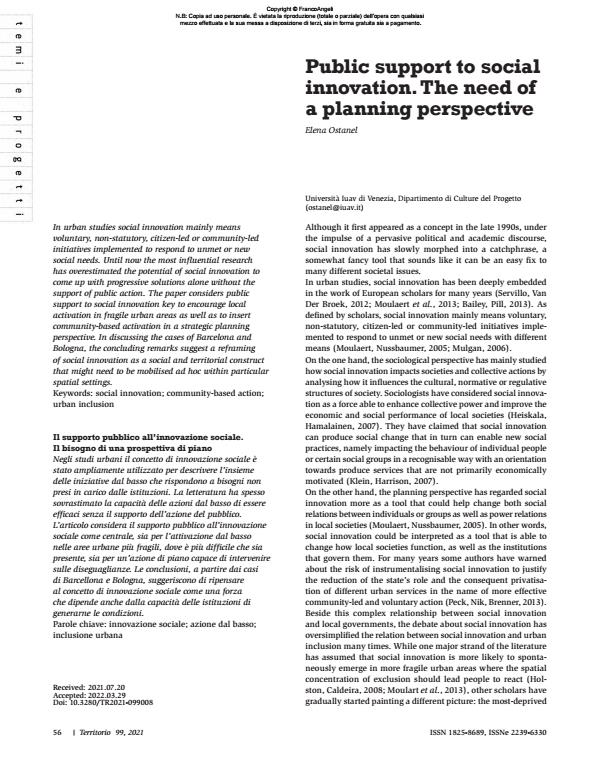Public support to socia innovation. The need of a planning perspective
Titolo Rivista TERRITORIO
Autori/Curatori Elena Ostanel
Anno di pubblicazione 2022 Fascicolo 2021/99
Lingua Inglese Numero pagine 5 P. 56-60 Dimensione file 119 KB
DOI 10.3280/TR2021-099008
Il DOI è il codice a barre della proprietà intellettuale: per saperne di più
clicca qui
Qui sotto puoi vedere in anteprima la prima pagina di questo articolo.
Se questo articolo ti interessa, lo puoi acquistare (e scaricare in formato pdf) seguendo le facili indicazioni per acquistare il download credit. Acquista Download Credits per scaricare questo Articolo in formato PDF

FrancoAngeli è membro della Publishers International Linking Association, Inc (PILA)associazione indipendente e non profit per facilitare (attraverso i servizi tecnologici implementati da CrossRef.org) l’accesso degli studiosi ai contenuti digitali nelle pubblicazioni professionali e scientifiche
In urban studies social innovation mainly means voluntary, non-statutory, citizen-led or community-led initiatives implemented to respond to unmet or new social needs. Until now the most influential research has overestimated the potential of social innovation to come up with progressive solutions alone without the support of public action. The paper considers public support to social innovation key to encourage local activation in fragile urban areas as well as to insert community-based activation in a strategic planning perspective. In discussing the cases of Barcelona and Bologna, the concluding remarks suggest a reframing of social innovation as a social and territorial construct that might need to be mobilised ad hoc within particular spatial settings.
Negli studi urbani il concetto di innovazione sociale è stato ampliamente utilizzato per descrivere l’insieme delle iniziative dal basso che rispondono a bisogni non presi in carico dalle istituzioni. La letteratura ha spesso sovrastimato la capacità delle azioni dal basso di essere efficaci senza il supporto dell’azione del pubblico. L’articolo considera il supporto pubblico all’innovazione sociale come centrale, sia per l’attivazione dal basso nelle aree urbane più fragili, dove è più difficile che sia presente, sia per un’azione di piano capace di intervenire sulle diseguaglianze. Le conclusioni, a partire dai casi di Barcellona e Bologna, suggeriscono di ripensare al concetto di innovazione sociale come una forza che dipende anche dalla capacità delle istituzioni di generarne le condizioni.
Parole chiave:innovazione sociale; azione dal basso; inclusione urbana
- Innovazione sociale: cosa cambia per la governance urbana? Una riflessione a partire dai casi di Inghilterra e Francia1 Francesca Bragaglia, in ARCHIVIO DI STUDI URBANI E REGIONALI 140/2024 pp.102
DOI: 10.3280/ASUR2024-140005
Elena Ostanel, Public support to socia innovation. The need of a planning perspective in "TERRITORIO" 99/2021, pp 56-60, DOI: 10.3280/TR2021-099008